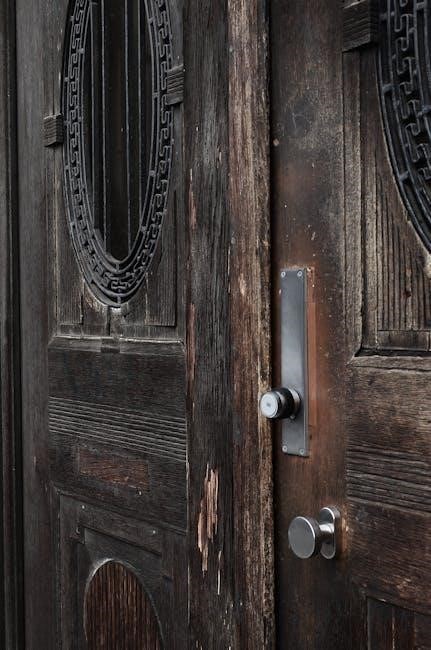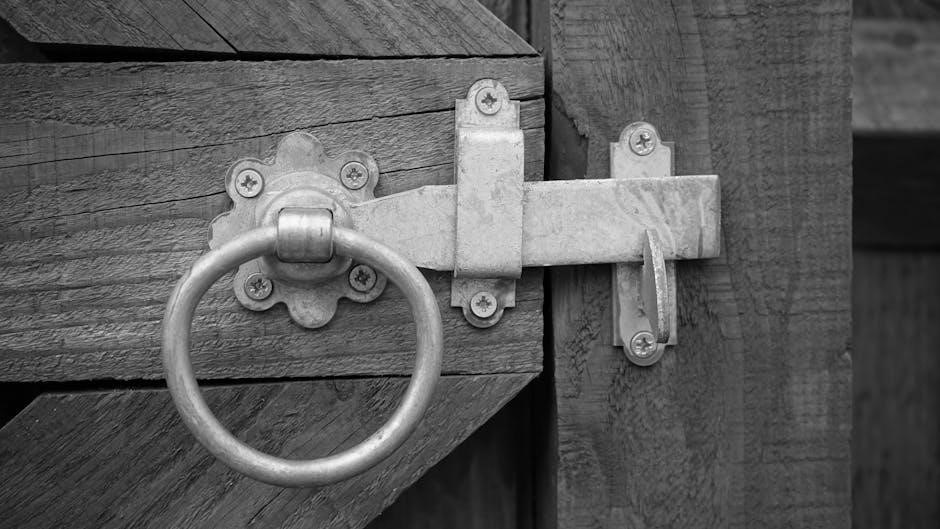To manually lock a garage door, certain steps must be taken, and
preparation
is key, including understanding the door’s locking mechanism and how it functions with the door’s springs and opener system properly.
Understanding the Importance of Manual Locking
Manual locking of a garage door is a crucial aspect of home security, providing an additional layer of protection against unauthorized access. The importance of manual locking lies in its ability to prevent potential break-ins and theft. A manual lock can be used in conjunction with an automatic opener, ensuring the door is secure even when the opener is not in use. This is particularly important for homes with valuable items stored in the garage. By understanding the importance of manual locking, homeowners can take steps to protect their property and prevent potential security breaches. The use of manual locks can also provide peace of mind, knowing that the garage door is secure and protected. Furthermore, manual locking can be used as a backup in case the automatic opener fails or is damaged. Overall, manual locking is a simple yet effective way to enhance home security and protect valuable assets.

Preparing the Garage Door for Manual Locking
Preparation involves checking the door’s condition and ensuring proper alignment for manual locking to function correctly always.
Disconnecting the Automatic Opener
To manually lock a garage door, one must first disconnect the automatic opener, which involves locating the emergency cord and pulling it to release the door from the opener’s mechanism. This step is crucial as it allows for manual operation of the door. The process of disconnecting the automatic opener may vary depending on the type of opener installed, but generally, it requires pulling the emergency cord to disengage the door from the opener. Once the door is disconnected, it can be manually locked or unlocked as needed. It is essential to follow the manufacturer’s instructions for disconnecting the automatic opener to avoid any damage to the door or the opener. By disconnecting the automatic opener, one can ensure the door is securely locked and prevent any unauthorized access. The door’s locking mechanism can then be engaged to provide an additional layer of security. Proper disconnection is necessary for safe and effective manual locking.

Locating the Door Lock and Emergency Cord
The door lock and emergency cord are usually found near the garage door opener, with the cord often having a red handle for easy identification and access to manual operation.
Releasing the Emergency Cord for Manual Operation
To release the emergency cord for manual operation, pull the cord down to disengage the automatic opener, allowing the door to be opened and closed manually. This is typically done by pulling the red handle attached to the cord, which will release the door from the opener’s mechanism. The door can then be lifted or lowered by hand, giving you full control over its movement. It’s essential to be careful when releasing the emergency cord, as the door may be heavy and difficult to manage. By following the proper procedure, you can ensure a safe and successful manual operation of your garage door. The process of releasing the emergency cord is relatively straightforward and can be completed with minimal effort, making it a convenient option for situations where the automatic opener is not functioning.

Unlocking and Locking the Garage Door Manually
Manually unlocking and locking involves using a latch or lock to secure the door in place, ensuring it is properly closed and cannot be opened from the outside easily always.
Ensuring the Door Springs are in Good Working Order
To manually lock a garage door, it is crucial that the door springs are in good working order, as they play a significant role in the door’s balance and smooth operation. The springs help to counterbalance the weight of the door, making it easier to open and close. If the springs are worn out or damaged, it can be challenging to manually lock the door, and it may not be secure. Therefore, it is essential to inspect the springs regularly and replace them if necessary. A properly balanced door with good working springs will ensure that the manual locking mechanism functions correctly, providing an additional layer of security to the garage. By checking the springs, homeowners can identify potential issues before they become major problems, and take steps to address them, ensuring the door operates smoothly and securely. This is an important step in maintaining the overall security of the garage.

Installing Garage Door Locks Safely and Correctly
Install locks with proper alignment and secure them firmly to the door frame for optimal security.
Putting Mechanical Locking Devices Out of Commission
To ensure safe and proper manual locking, it is essential to put mechanical locking devices out of commission, especially when using a garage door operator. This includes removing or disabling any unnecessary locking mechanisms that may interfere with the door’s operation. By doing so, you can prevent potential accidents or damage to the door and its components. The process involves identifying the mechanical locking devices that are not needed and taking steps to render them inoperable. This may require consulting the door’s manual or seeking professional assistance. It is crucial to follow the manufacturer’s instructions and take necessary precautions to avoid any potential risks. Additionally, it is recommended to inspect the door and its locking mechanisms regularly to ensure they are functioning correctly and safely. Properly putting mechanical locking devices out of commission is vital for maintaining the overall security and functionality of the garage door. Regular maintenance and inspection can help prevent issues and ensure smooth operation.
Additional Considerations for Manual Garage Door Locking
When manually locking a garage door, there are several additional considerations to keep in mind. The door’s material and construction can affect its security and locking mechanism. For example, wooden doors may require different locking methods than metal doors. It is also essential to consider the door’s size and weight, as larger and heavier doors may require more robust locking systems. Furthermore, the location of the door and its surroundings can impact its security, with doors in high-traffic areas or near valuables requiring extra precautions. Regular maintenance and inspection of the door and its locking mechanism are crucial to ensure they are functioning correctly and securely. By taking these factors into account, individuals can ensure their garage door is properly secured and protected from potential threats. A secure garage door can provide peace of mind and help prevent unauthorized access to the garage and its contents. Proper consideration of these factors is vital for effective manual garage door locking.